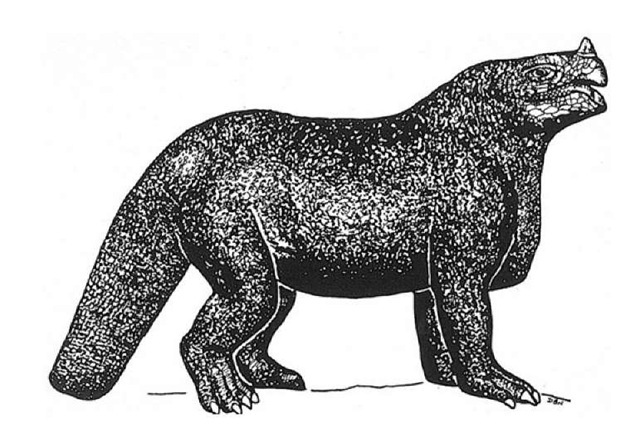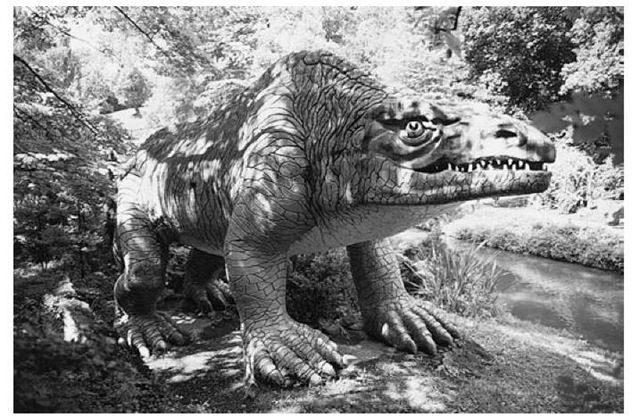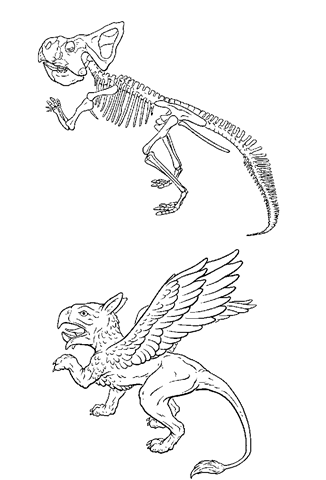Dinosaurs were ‘borne’ officially in 1842 as a result of some truly brilliant and intuitive detective work by the British anatomist Richard Owen (Figure 1), whose work had concentrated upon the unique nature of some extinct British fossil reptiles.
At the time of Owen’s review, he was working on a surprisingly meagre collection of fossil bones and teeth that had been discovered up to that time and were scattered around the British Isles. Although the birth of dinosaurs was relatively inauspicious (first appearing as an afterthought in the published report of the 11th meeting of the British Association for the Advancement of Science), they were soon to become the centre of worldwide attention. The reason for this was simple. Owen worked in London, at the Museum of the Royal College of Surgeons, at a time when the British Empire was probably at its greatest extent. To celebrate such influence and achievement, the Great Exhibition of 1851 was devised. To house this event a huge temporary exhibition hall (Joseph Paxton’s steel and glass ‘Crystal Palace’) was built on Hyde Park in central London.
Rather than destroy the wonderful exhibition hall at the end of 1851 it was moved to a permanent site at the London suburb of Sydenham (the future Crystal Palace Park). The parkland surrounding the exhibition building was landscaped and arranged thematically, and one of the themes depicted scientific endeavour in the form of natural history and geology and how they had contributed to unravelling the Earth’s history. This geological theme park, probably one of the earliest of its kind, included reconstructions of genuine geological features (caves, limestone pavements, geological strata) as well as representations of the inhabitants of the ancient world. Owen, in collaboration with the sculptor and entrepreneur Benjamin Waterhouse Hawkins, populated the parkland with gigantic iron-framed and concrete-clad models of dinosaurs (Figure 2) and other prehistoric creatures known at this time. The advance publicity generated before the relocated ‘Great Exhibition’ was re-opened in June 1854 included a celebratory dinner held on New Year’s Eve 1853 within the belly of a half-completed model of the dinosaur Iguanodon and this ensured considerable public awareness of Owen’s dinosaurs.
1. Professor Richard Owen (1804-92)
The fact that dinosaurs were extinct denizens of hitherto unsuspected earlier worlds, and were the literal embodiment of the dragons of myth and legend, probably guaranteed their adoption by society at large; they even appeared in the works of Charles Dickens, who was a personal acquaintance of Richard Owen. From such evocative beginnings public interest in dinosaurs has been nurtured and maintained ever since. Quite why the appeal should have been so persistent has been much speculated upon; it may have much to do with the importance of story-telling as a means of stimulating human imaginative and creative abilities. It strikes me as no coincidence that in humans the most formative years of intellectual growth and cultural development, between the ages of about 3 and 10 years, are often those when the enthusiasm for dinosaurs is greatest – as many parents can testify. The buzz of excitement created when children glimpse their first dinosaur skeleton is almost palpable. Dinosaurs, as the late Stephen Jay Gould – arguably our greatest popularizer of scientific natural history – memorably remarked, are popular because they are ‘big, scary and [fortunately for us] dead’, and it is true that their gaunt skeletons exert a gravitational pull on the imaginative landscape of youngsters.
A remarkable piece of evidence in support of the notion that there is a relationship between the latent appeal of dinosaurs and the human psyche can be found in mythology and folklore. Adrienne 2. Top: a sketch of the Iguanodon model at Crystal Palace.
A photograph of the model of Megalosaurus in Crystal Palace Park.
Mayor has shown that as early as the 7th century bc the Greeks had contact with nomadic cultures in central Asia. Written accounts at this time include descriptions of the Griffin (or Gryphon): a creature that reputedly hoarded and jealously guarded gold; it was wolf-sized with a beak, four legs, and sharp claws on its feet. Furthermore, Near East art of at least 3000 bc depicts Griffin-like creatures, as does that of the Mycenaean. The Griffin myth arose in Mongolia/north-west China, in association with the ancient caravan routes and gold prospecting in the Tienshan and Altai Mountains. This part of the world (we now know) has a very rich fossil heritage and is notable for the abundance of well-preserved dinosaur skeletons; they are remarkably easy to find because their white fossil bones stand out clearly against the soft, red sandstones in which they are buried. Of even greater interest is the fact that the most abundant of the dinosaurs preserved in these sandstones is Protoceratops, which are approximately wolf-sized, and have a prominent hooked beak and four legs terminated by sharp-clawed toes. Their skulls also bear strikingly upswept bony frills, which might easily be the origin of the wing-like structures that are often depicted in Griffin imagery (compare the images in Figure 3). Griffins were reported and figured very consistently for more than a millennium, but beyond the 3rd century ad they became defined increasingly by allegorical traits. On this basis it would appear to be highly probable that Griffins owe their origin to genuine observations of dinosaur skeletons made by nomadic travellers through Mongolia; they demonstrate an uncanny link between exotic mythological beasts and the real world of dinosaurs.
Looked at through the harsh lens of objectivity, the cultural pervasiveness of dinosaurs is extraordinary. After all, no human being has ever seen a living non-avian dinosaur (no matter what some of the more absurd creationist literature might claim). The very first recognizably human members of our species lived about 500,000 years ago. By contrast, the very last dinosaurs trod our planet approximately 65 million years ago and probably perished, along with many other creatures, in a cataclysm following a giant meteorite impact with Earth at that time (see topic 8). Dinosaurs, as a group of animals of quite bewildering variety, therefore existed on Earth for over 160 million years before their sudden demise. This surely puts the span of human existence, and our current dominance of this fragile planet (in particular, the debates concerning our utilization of resources, pollution, and global warming), into a decidedly sobering perspective.
3. The Griffin of mythology exhibits all the key anatomical attributes of Protoceratops, whose skeletons would have been observed by travellers on the Silk Road through Mongolia
The very fact of the recognition of dinosaurs, and the very different world in which they lived, today is a testament to the extraordinary explanatory power of science. The ability to be inquisitive, to probe the natural world and all its products, and to keep asking that beguilingly simple question – why? – is one of the essences of being human. It is hardly surprising that developing rigorous methods in order to determine answers to such general questions is at the core of all science.
Dinosaurs are undeniably interesting to many people. Their very existence incites curiosity, and this can be used in some instances as a means of introducing unsuspecting audiences to the excitement of scientific discovery and the application and use of science more generally. Just as fascination with bird songs could lead to an interest in the physics of sound transmission, echolocation, and ultimately radar, on the one hand, or linguistics and psychology on the other; so it can be that an interest in dinosaurs can open pathways into an equally surprising and unexpectedly wide range of scientific disciplines. Outlining some of these pathways into science is one of the underlying purposes of this topic.
Palaeontology is the science that has been built around the study of fossils, the remains of organisms that died prior to the time when human culture began to have an identifiable impact on the world, that is more than 10,000 years ago. This branch of science represents our attempt to bring such fossils back to life: not literally, as in resuscitating dead creatures (in the fictional Jurassic Park mode), but by using science to understand as fully as we can what such creatures were really like and how they fitted into their world. When a fossil of an animal is discovered, it presents the palaeontologist with a series of puzzles, not unlike those faced by the fictional sleuth Sherlock Holmes:
• What type of creature was it when it was alive?
• How long ago did it die?
• Did it die naturally of old age, or was it killed?
• Did it die just where it was found, buried in the rock, or was its body moved here from somewhere else?
• Was it male or female?
• How did the creature look when it was alive?
• Was it colorful or drab?
• Was it fast-moving or a slow-coach?
• What did it eat?
• How well could it see, smell, or hear?
• Is it related to any creatures that are alive today?
These are just a few examples of the questions that might be asked, but all tend towards the piecemeal reconstruction of a picture of the creature and of the world in which it lived. It has been my experience, following on from the first broadcasting of the television series called Walking with Dinosaurs, with their incredibly realistic-looking virtual dinosaurs, that many people were sufficiently intrigued by what they saw or heard in the commentary to ask: ‘How did you know that they moved like that? … looked like that? … behaved like that?’
Questions driven by uncomplicated observations and basic common sense underpin this topic. Every fossil discovery is in and of itself unique and has the potential to teach the inquisitive among us something about our heritage as members of our world. I should, however, qualify this statement by adding that the particular type of heritage that I will be discussing relates to the natural heritage that we share with all other organisms on this planet. This natural
heritage spans a period of time that exceeds 3,800 million years according to most modern estimates. I will be exploring only a tiny section of this staggeringly long period of time: just that interval between 225 and 65 million years ago, when dinosaurs dominated most aspects of life on Earth.




